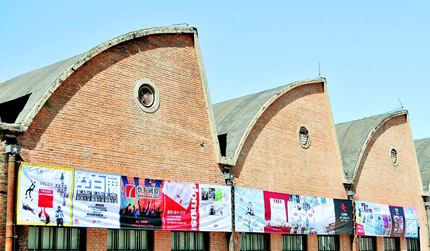Chinese art market in the shadow of financial crisis
The financial crisis has battered China's art landscape, shrinking investment in grand schemes like Songzhuang, shuttering galleries in Beijing's pioneering 798 arts district and deflating bloated egos, valuations and excesses.
The fallow plots of farmland on the edge of the artists' village of Songzhuang are a symbol of Chinese contemporary art's recent boom-and-bust cycle.
|
After a white-hot stint, the financial crisis has battered China's art landscape, shrinking investment in grand schemes like Songzhuang, shuttering galleries in Beijing's pioneering 798 arts district (above) and deflating bloated egos, valuations and excesses. [Shanghai Daily] |
When prices for Chinese art soared, there were grand plans to build more galleries and studios in this artists' hamlet near Beijing. Yet today, after art prices plunged by some 60 percent in the past year, the expansion plans have foundered.
After a white-hot stint, the financial crisis has battered China's art landscape, shrinking investment in grand schemes like Songzhuang, shuttering galleries in Beijing's pioneering 798 arts district and deflating bloated egos, valuations and excesses.
"The Chinese contemporary market was over-swollen before. I felt it wasn't very healthy," says Nan Xi, a former Chinese army officer-turned-artist whose works, huge pointillist ink-brush canvasses that he displays in his spacious Songzhuang villa, fetched around half a million yuan (US$73,283) at the peak of the market.
In the good days, ferocious bidding in auction rooms at the market's peak in 2007 and 2008 caused prices to spiral skyward with buyers and speculators treating contemporary artwork almost like stocks or tradeable commodities.
What resulted was a glut of average art at inflated prices and a growing community of millionaire artists, some more drawn by the opportunities to make vast amounts of cash than any artistic vision.
"The financial crisis has been a good lesson for us; to better know what the market is and art's relationship to it. Having too much money is not good for an artist's development," says Nan.
Reasonable prices
China's leading auction house, Beijing Poly International Auction, which is famous for its repatriation of looted bronze animal heads from the West, has seen business in Chinese contemporary art plunge over 50 percent in the past year.
"A lot of buyers have been pushed out, including the speculators. The collectors who are left are now able to pay more reasonable money for reasonable things," says Li Da, Poly's general manager.
He gives the example of a large Zhang Xiaogang bloodline painting that fetched 16.8 million yuan (US$ 2.5 million) in May and says that painting would have sold for more than twice that amount if it had been auctioned in 2007.
Melancholy canvasses by Zhang, one of China's A-list artists including the likes of Liu Xiaodong, Zeng Fanzhi, Fang Lijun, Cao Guoqiang and Yue Minjun, sold at up to US$6 million a piece at the market peak.
Those valuations have, like many others, since fallen some 66 percent according to an index on Chinese art Website Artron.net.
Since 2007, the overall market for Chinese contemporary art has shrunk over 54 percent according to Artron.
Sotheby's and Christie's, which both pared back their sales of Chinese contemporary art in Hong Kong, have struggled to consign outstanding works, with sellers still wary of fragile sentiment.
At Sotheby's autumn sales, bidding was mixed for contemporary art with Zhang Xiaogang's "Comrade," one of the few pieces testing the US$1 million mark.
Without an across-the-board recovery in China's economy and a return to the days of huge wealth creation, Li says she doesn't see a comeback in Chinese contemporary art prices anytime soon.
"Right now, the market is still consolidating," says Tim Lin, a veteran Taiwanese gallery owner at the recent Sotheby's autumn sales in Hong Kong that are considered a barometer of the market.
"The market will go up, but you can't just focus on the short term. See it like a flower, if it blooms too quickly, it will wither quickly. You need to look at the long term."
Auctioneers and dealers say collectors have become more selective since the crash, spurning lesser works while seeking value in younger artists beyond China in Asia and in the West.
"Through this consolidation, there will be better discernment of good artists and good works and their inherent value," says Li of the Poly Group. "The true connoisseurs of Chinese contemporary art, the collectors are left ... and they will be able to pay reasonable money for reasonable things."
Misung Shim, the head of Seoul Auction, which sold a large work of British artist Damien Hirst in Hong Kong this month for US$2.2 million, an auction record for the artist in Asia, sees growing opportunities beyond China's art scene.
 0
0 







